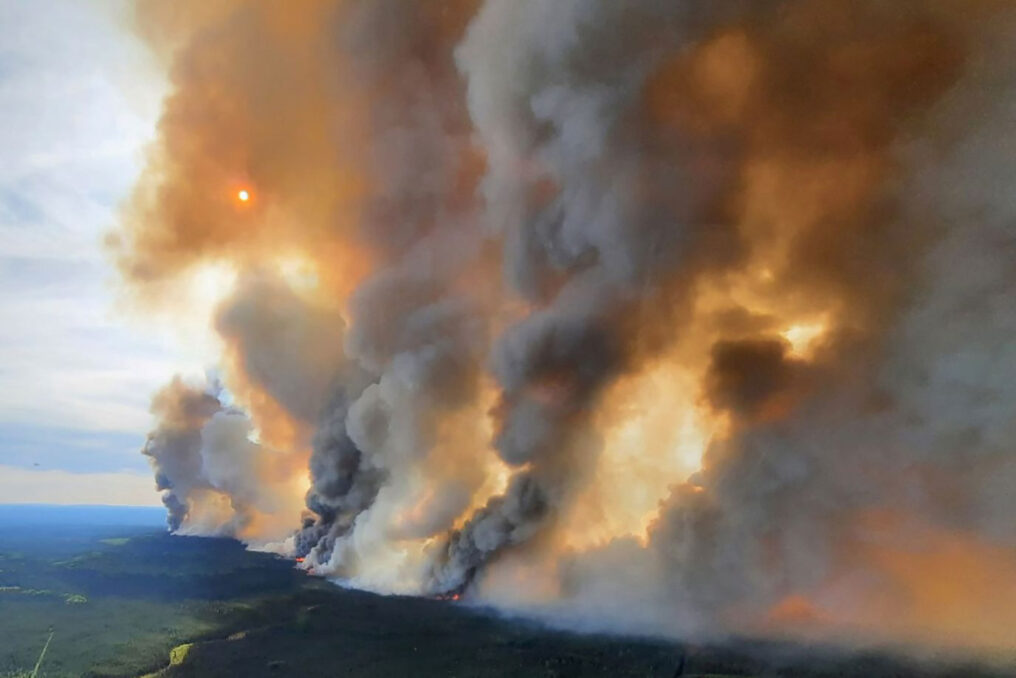Cities in the eastern United States were engulfed in smoke from wildfires on the west coast, making New York the world’s most polluted city.
On Wednesday, New York City experienced yellowing and ashen skies caused by smoke from Canadian wildfires, resulting in unhealthy air conditions throughout the northeastern United States. After experiencing a slight improvement in air quality on June 7, the situation quickly deteriorated in the afternoon with New York’s AQI surging to over 400, indicating deplorable air conditions.
This level is considered the worst globally and approximately 58 times higher than the guidelines set by the World Health Organization.
Several New Yorkers took to social media to share pictures of the city, capturing a sight that was rarely witnessed before. Landmark buildings and bridges were gradually disappearing from view as they became obscured by a dense curtain of smog. Even the Statue of Liberty, which is typically visible on a clear June day, appeared as a dark blur on the horizon when observed from the shoreline of lower Manhattan along the Hudson River.
The unprecedented level of smog created an eerie atmosphere and prompted residents to document this unusual occurrence through photographs shared online.

Public Advisory issued
As a result of the deteriorating air quality, education departments in New York City and Washington DC decided to cancel outdoor activities in public schools. In response to the persistently poor air quality, Governor Kathy Hochul of New York issued a strong recommendation to all school districts to implement measures to address the situation, saying that the AQI is going to remain in the “unhealthy to very unhealthy” range until Wednesday night.
The Governor’s appeal aimed to prioritize the health and well-being of students and staff by taking necessary precautions and adjusting activities accordingly.
New York officials also advised sickness-prone individuals, such as those having asthma and heart disease, to avoid arduous outdoor activities due to escalated air pollution. The air quality had reached a level surpassing Lima in Peru and Kolkata in India, ranking as the worst in the world.
The source of smoke
The haze and plummeting air quality in eastern cities of the United States and Canada, including Philadelphia, Washington DC, Pittsburgh, Toronto, and New York, were caused by smoke emanating from over 80 major wildfires in the western part of the US. These conditions led to fiery sunrises and even a rare red tinge bathing the moon on Tuesday night.

Greg Pope, a professor of earth and environmental studies at Montclair State University, noted the unprecedented nature of the situation, mentioning that he couldn’t even see the Manhattan skyline from his New Jersey office. The presence of this level of haze was highly unusual and not something he had observed before.
Let’s not forget California
While scenes of intense wildfires and their resulting air pollution are relatively rare in regions of the United States outside of the West Coast, it is a different story on the other half. Many major cities across the West Coast like California regularly endure high levels of air pollution caused by perennial wildfires affecting residents throughout the year.
This persistent smog is a year-round problem in those areas and could potentially become more widespread globally as the climate crisis continues to escalate. As the impacts of climate change worsen, more regions worldwide will likely experience similar challenges with air pollution and its associated health risks.

What is causing climate change?
For the second consecutive year, smoke from massive wildfires in the western United States has travelled 2,000 miles to the east. This occurrence can be attributed to the ongoing drought and extreme temperatures in the western states, which are intensified by human-induced climate change.
Though wildfires are not directly caused by climate change, there is a strong connection between climate change and the conditions that contribute to their intensity and frequency. Factors such as droughts, high temperatures, and dry vegetation, which are exacerbated by climate change, lead to severe and widespread wildfires.
Climate change is a significant factor in the increased fire activity in Canada observed in recent years. It is projected that the area burned by wildfires annually may double by the end of the century due to climate change. This highlights the long-term implications of climate change on wildfire patterns and the urgent need to address its underlying causes.

While the smoke is expected to dissipate from New York in the following days, it is anticipated that widespread wildfires will continue to pose a threat in the upcoming months. The people in the western United States are particularly affected by both the smoke and the direct dangers of the flames.













